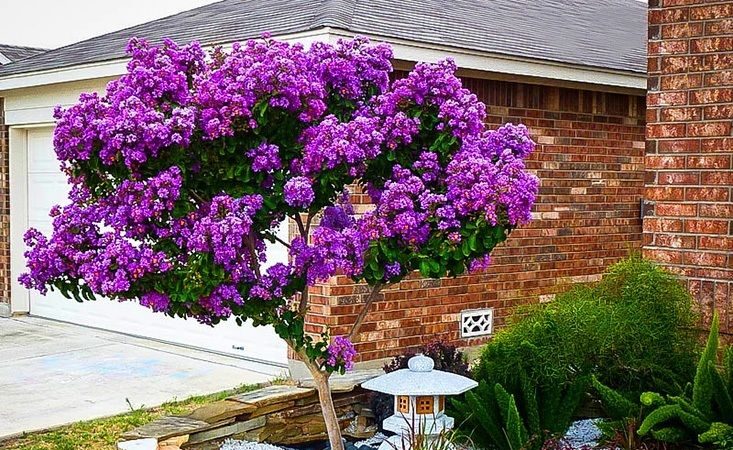Summer Marvel in Your Garden: This Stunning Tree Blooms Non-Stop Throughout the Summer

The tree mentioned in the title of the article is not very popular and well-known in our gardens, but during its flowering it immediately catches the eye and steals the hearts of every plant lover. Indian lagerstremia – I’m talking about it (it is also sometimes calledlilac of the south) is a real summer wonder that delights with its long flowering, beautiful colorful flowers and unusual bark on the trunk.
The Indian lagerstroemia is an absolutely gorgeous tree. It can grow to be anywhere from 2 to 9 meters tall, depending on the variety. This lovely plant has an upright, spreading habit that’s perfect for brightening up gardens, parks, and terraces. The flowers of lagerstremia are truly its greatest pride and joy! This plant is a true summer gem! It blooms continuously from July to September, delighting us with its beautiful flowers. Its flower panicles, which can reach a length of 15 to 45 cm, are a feast for the eyes in shades of pink, red, purple, and white. They decorate gardens throughout the summer, creating a colorful spectacle. Its long-lasting blooms make this plant an irreplaceable decorative element in the garden, attracting the eyes of everyone who sees it.
In addition to its beautiful flowering, Indian lagerstremia has another charming feature – its bark begins to peel off in winter, revealing a smooth, unique trunk at its base. This peeling adds even more unique character and attractiveness to the plant.
Care and cultivation of Indian lagerstremia
Indian lagerstremia grows best in full sun (too much shade will make the blooms less showy). It prefers well-drained soils, but is able to adapt to a variety of soil conditions including sandy soil, clay soil and even slightly acidic or alkaline soil. It is drought tolerant, making it an ideal choice for sunny spots in the garden.
When planting lagerstremia, provide it with enough space to reach its full size – plant it in places where it will not interfere with paths or utility installations. These plants should be placed a minimum of 3-4.5 meters from foundations, driveways or terraces.
An important aspect of its care is its regular pruning, which is best done in late winter, before spring growth begins. Pruning not only helps to maintain the nice shape of the plant, but also promotes more abundant flowering. Never prune in autumn or early winter, as new growth can be damaged by low temperatures. If you do decide to prune, remove suckers that are dead or damaged branches near the trunk, using hand pruners or loppers. Remove overripe flowers in summer to encourage the plant to bloom again. Over time, by pruning the plant regularly, you can gradually lift the lower branches to show the decorative pattern of the trunk.
Lagerstremia is also resistant to most diseases, although it may be subject to attacks from aphids, among others.
Varieties and uses in the garden
The varieties of lagerstremia themselves are numerous and each has its own unique characteristics. It is worth mentioning some of the main ones such as:
- Hybrid ‘Acoma‘ – reaching 4-5m in height, characterized by white flowers, purple-red leaves in autumn, is resistant to powdery mildew.
- Hybrid ‘Biloxi‘ – growing to about 7meters, with pale pink flowers, orange-red leaves in autumn. It is a hardy variety that is also resistant to powdery mildew.
- ‘Cherokee‘ – variety much lower than the others, grows up to 3-3,5 meters high, with bright red flowers.
- ‘Powhatan‘ – grows up to 4-6 meters in height. It has very pure yellow leaves in autumn and medium purple flowers.
- Hybrid ‘Natchez‘ – One of the taller varieties reaching 9m in height, with pure white flowers, resistant to aphids, considered one of the best varieties of lagerstremia.
- Hybrid ‘Muskogee‘ – A variety growing to about 7m, with light lavender flowers.
- ‘Tuscarora‘ – up to 5m tall, with dark coral pink flowers.
Thanks to this variety, every gardening lover will find something for himself in this tree. Indian Lagerstremia is not only beautiful, but also versatile. It can be planted as a solitary, in groups to form showy hedges, as well as in containers on terraces. Its decorative bark, which peels to reveal a variety of shades of brown and gray, also adds beauty outside the flowering season.
For all those who have fallen in love with this beautiful tree, I leave two videos. The first shows a young Indian Lagerstremia tree, showing its charm in its full glory. The second video, in turn, takes you to a nursery full of these beautiful plants, where you can see the whole range of colors and forms.
Interesting facts about Indian lagerstromeria
For all garden lovers and people who have fallen in love with Indian lagerstremia, I will leave some fascinating facts about it, so that you can impress your neighbors or friends with less obvious aspects about this plant.
- Indian lagerstem has been cultivated for nearly 1,600.
- The plant contains alkaloids, cardiac glycosides, tannins, saponins, sterols, triterpenes, anthraquinones, reducing compounds, flavonoids and phenolic glycosides. Lagerstromia exhibits anti-inflammatory, analgesic, antipyretic, antioxidant, anticancer, antimicrobial, anti-Alzheimer’s disease and antidiabetic.
- It has been used in folk medicine for a long time for various purposes. The bark of Indian lagerstem was used as a stimulant and antipyretic. The leaves and flowers were used as a laxative. The root, on the other hand, was used as an astringent, detoxifier, diuretic.

